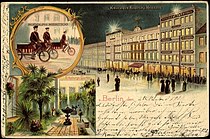Rudolph Hertzog
Rudolph Hertzog Sr. (* June 15, 1815 in Berlin ; † May 2, 1894 in Karlsbad ; full name: Rudolph Carl Hertzog ) was a German entrepreneur in the textile retail trade .
Life
Hertzog founded the supraregional department store Rudolph Hertzog in Berlin (in the historic district of Cölln ) until after the Second World War . The manufactured goods store in the house at Breite Straße 13 , which he founded in 1839, developed into one of the best-known addresses for furniture, carpets, fashion goods and fabrics through mail order . Hertzog was one of the first to introduce fixed prices in Berlin and print advertisements, as well as an annual agenda of around 200 pages that was overseen by Paul Lindenberg and Rudolf Pietsch , among others .
In 1884, while Bismarck was still alive, Rudolph Hertzog offered Kaiser Wilhelm I an advance payment of one million marks for a Bismarck monument in Berlin. However, this request was rejected.
Rudolph Hertzog started out in 1839 as one of around 150 existing manufactured goods stores in Berlin. In 1848 his shop had a size of 155 m², but increasing sales allowed regular renovations. In 1867 it had 2,290, 1878 3,710 and 1892 5,405 m². In 1904 the company erected a new imposing building on the opposite Brüderstraße , so that a total area of 10,800 m² and in 1912 finally 15,875 m² was used. In 1912, the department store complex covered almost the entire square up to the Brüderstraße between Scharrenstraße and Neumannsgasse. Here a marble bust created by Adolf Brütt is a reminder of the company's founder. Before the First World War, Rudolph Hertzog was the largest department store in Berlin, larger than the leading department stores, namely Wertheim and Hermann Tietz.
A branch of the department store was located in Swakopmund in German South West Africa , which is still standing today.
The company's last building in Berlin on the corner of Brüderstraße and Scharrenstraße was an existing four-storey building with a slightly simplified facade after the war damage had been repaired, with a plastered facade in neo-baroque shapes with an entrance front, created in 1908/1909 by the architect Gustav Hochgürtel . The other buildings were demolished in the course of the redevelopment and redesign of Breite Strasse.
The son Rudolph L. Hertzog and the grandson Rudolph Hertzog continued the "Rudolph Hertzog" company. Since the owners were Christian, their company was the only one of the Berlin “clothing founders” to survive the Nazi era . In 1949, however, the heirs who had managed the business, which was now in the communist-ruled eastern part of Berlin, were expropriated . In 1970 the building was extensively repaired. After that, until 1990, at the end of the GDR , the building was used as a wedding outfitter and a youth fashion department store. The building was completely renovated between 2015 and 2018.
Rudolph Hertzog is buried in the cemetery of the Dorotheenstädtische and Friedrichswerder Parishes II. The grave of the Hertzog family in the cemetery is a listed building .
literature
- Marina Wesner, Claudia M. Melisch: St. Petri Church. A tour through the historic Cölln in Berlin. Berlin-Story, Berlin 2008, ISBN 3-929829-87-8 , p. 83 ff.
Web links
- Rudolph Hertzog department store . In: Luise-Berlin archived in the Internet archive .
- Rudolph Hertzog . In: Luise-Berlin archived in the Internet archive .
- Rudolph Hertzog . In: berlin.friedparks.de
- Hertzog family . In: schulz-pearce.de
Individual evidence
- ↑ uwespiekermann: Against the fixation in department stores . The beginnings of the Rudolph Hertzog department store. In: Uwe Spiekermann. June 2, 2018, accessed on May 15, 2019 (German).
- ^ Hertzog Swakopmund department store. In: Bildarchiv Preussischer Kulturbesitz.
- ↑ Entry in the Berlin State Monument List with further information
- ↑ Rudolph Hertzog Agenda 1914 . Pp. 66-68.
- ^ Uwe Westphal: Berliner Konfektion und Mode 1839–1939. The destruction of a tradition. (= Sites of the History of Berlin , Volume 14.) Edition Hentrich, Berlin 1986, p. 16.
| personal data | |
|---|---|
| SURNAME | Hertzog, Rudolph |
| ALTERNATIVE NAMES | Hertzog, Rudolph Carl (full name) |
| BRIEF DESCRIPTION | German entrepreneur in the textile retail sector, founder of a department store |
| DATE OF BIRTH | June 15, 1815 |
| PLACE OF BIRTH | Berlin |
| DATE OF DEATH | May 2, 1894 |
| Place of death | Carlsbad |



